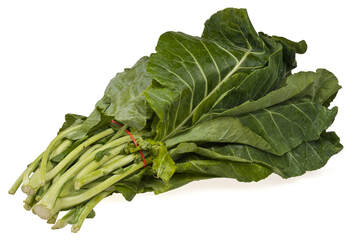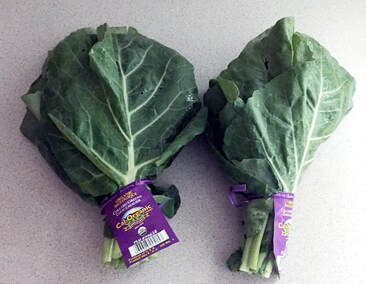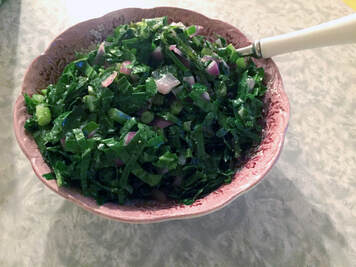 Collards have a reputation for needing to be cooked for hours and end up smelling up the house. This couldn’t be further from the truth. They can be enjoyed raw, steamed or lightly cooked. Or, long-cooked, such as with ham hocks. Collards are one of the oldest vegetables found in the same cruciferous vegetable family as some of the other vegetables I’ve written about in this blog: Turnip, rutabaga, kohlrabi and Brussels sprouts. As well as broccoli and cabbage, among others. Collards are sometimes called “tree cabbage” and “non-heading cabbage.” (1) While collards are hearty enough to grow during the winter, they usually are available year-round. They are a versatile option for recipes, as you can find below. What do collards taste like?  Collard leaves can range from a lighter shade of green to a deep shade. The leaves are flat with a thick rib through the center. Many folk will cut out the ribs and throw them away, but the ribs have good flavor and nutrition. See below for preparation tips. Some say their flavor is bitter, others say they are more alkaline. Some say you must cook them for ages. Others know you do not need to. Now is the time to find some fresh, tender leaves! Avoid the brittle leaves. As with Brussels sprouts, when cooked too long, the sulfur in collards can smell up the kitchen. That smell is a compound that fights cancer. See the section called “How nutritious are collards?” for more details. How do you prepare collards?  To enjoy them cooked or raw, it’s common practice to cut the ribs out from the leaves first. This is because the ribs and the leaves are different textures and thicknesses. Depending on the dish, finely chop the ribs to use within the dish or save for another dish. One of my favorite ways to use the ribs is to sauté them with chopped peppers and onions. I call it “confetti greens.” Once the ribs are removed, collard leaves are often rolled up and chopped very finely, before sautéing or slow cooking. Leaves can also be used as an alternative to a tortilla wrap. Some steam them before using to aid in rolling; others use the fresh leaves raw. I recommend using the steaming method if the leaves are a bit older. Note: Some folks find cruciferous vegetables a little bitter. If you raise the pH of the dish by adding some vinegar or citrus juice (lemon or lime), this can help tone down the bitterness. How nutritious are collards?Collards are low in calories and are an excellent source of vitamins A, C and K. They are also a good source of fiber (2). Studies show that cruciferous vegetables play a key role in the following: cancer-fighting, detoxification, anti-inflammatory, and heart health, among other benefits. Click here to read more about their “super food” capabilities. Leave a comment below and let me know how you enjoy this delicious vegetable! References: Garlic-Sautéed GreensServes 4-6 Adapted from The Cancer Lifeline Cookbook Ingredients:
Directions:
Note: Freezes well; add other colors, such as chopped red peppers, for variety of texture, color and flavor. Adapted from: Cancer Lifeline Cookbook. By Kimberly Mathai, MS, RD with Ginny Smith. Sasquatch Books; 2nd edition (May 11, 2004), page 154. Click here for more recipe ideas! ~ Nancy Miller, MS, RDN
0 Comments
Leave a Reply. |
SD BlogA place for our consultant Registered Dietitian Nutritionists (RDNs) to share nutrition science, yummy and healthy recipes, tips on seasonal ingredients, and other nutritional musings. Enjoy! Categories
All
Archives
May 2024
|


 RSS Feed
RSS Feed